Blog, Destinations, Peru, South America
Peru Travel Guide: Top 10 Things to Do in Cusco
Last updated on July 29th, 2024 at 04:46 pm
Cusco, Peru, is nestled in the Andes mountain range at a breathtaking altitude of 3400m (11,100ft). For many visitors, it is the starting point for a multi-day trek to Machu Picchu. A place to acclimatize to the altitude while exploring nearby Incan ruins and eating delicious food. For others, it’s a place to learn about Incan history, as Cusco was the capital of the Inca Empire. While some visit to learn more about themselves through ayahuasca ceremonies. Cusco was one of my favorite places I visited in Peru. I loved the bohemian energy, learning about the history of the ancient city, and eating some of the best food I’ve ever had. In this guide, I’ll share what to do in Cusco so you can craft your dream Cusco itinerary.
This post contains affiliate links which means if you decide to make a purchase I’ll earn a small commission at no additional cost to you.
peru travel resources
- Book your flight to Peru with Omio
- Get reliable travel insurance with World Nomads
- Find awesome accommodation with booking.com or Hostelworld
- Want to add guided tours to your itinerary? Here are the top 10 tours in Peru
- The best way to see Peru in a week!
- Get the essentials for trip to Peru here: my favorite waterproof booties, this power bank to stay connected, and a reusable water bottle
A Brief History of Cusco, Peru
I think it’s important to understand the history of the places we visit, especially when they’re as culturally significant as Cusco.
Cusco has existed since 1200 AD, but it became the capital of the Inca Empire in the 15th century. At the time, the Inca empire extended from Ecuador to Chile! During this time, the Incans created fortresses with massive stone walls, like Sacsayhuamán, and sacred religious sites like Qorikancha, the Temple of the Sun. Both of these can still be seen standing today.
However, in the 16th century, the Spanish conquest brought the fall of the Incan empire. The Spanish conquistadors dismantled many Inca structures, either repurposing the stones for their colonial buildings or simply building their colonial structures on top of the stones (you’ll see this a lot!).
Today, Cusco is a UNESCO World Heritage site, and there is a sense of pride in the Indigenous traditions and Incan culture. There is also a thriving Quechua-speaking community. Quechua was the native language. Of course, Cusco now draws millions of tourists to the city each year for its rich history and as the jumping-off point to Machu Picchu and the rest of the Sacred Valley.
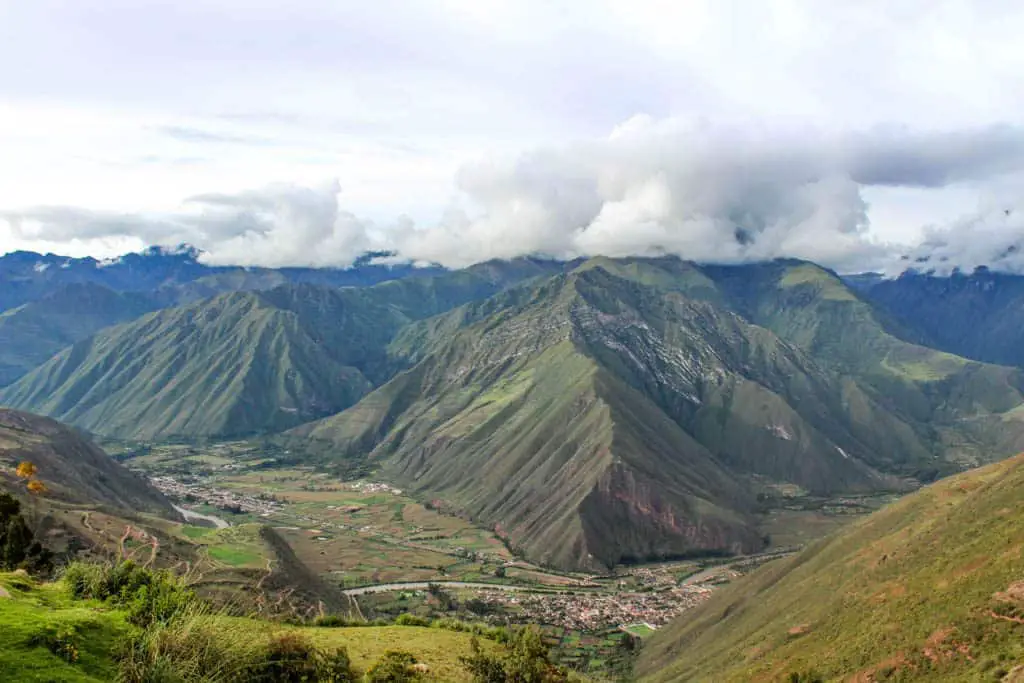
How to Get to Cusco, Peru
Cusco By Air
The quickest option, and the one that I chose, is to fly to Cusco. While there are some international flights directly to Cusco, most flights connect through Lima. I highly recommend spending a few days exploring the fun things to do in Lima before continuing on to Cusco (this is what I did).
The flight from Lima to Cusco takes about 1.5 hours, and airlines like LATAM and Viva Air offer multiple daily flights.
There are also direct domestic flights to Cusco from cities like Arequipa, Juliaca (near Lake Titicaca), and Puerto Maldonado (the gateway to the Amazon rainforest).
Cusco By Bus
If you have more time on your schedule and want to take the scenic route, you could take a bus to Cusco.
From Lima: Several bus companies offer overnight services from Lima to Cusco, with the journey taking approximately 20-22 hours. Notable companies include Cruz del Sur and Oltursa, which provide comfortable and safe rides with reclining seats and onboard amenities.
From Arequipa: If you’re coming from the “White City” of Arequipa, the bus journey to Cusco is around 10-12 hours. Companies like Cruz del Sur and Civa are reliable options.
From Puno: For those visiting Lake Titicaca, a bus ride from Puno to Cusco takes about 8-9 hours. This route often includes stops at fascinating archaeological sites and local markets.
If you’re opting for a bus journey, I highly recommend booking with Peru Hop. I used them to make my Peru itinerary happen in a budget-friendly and non-overwhelming way. I took them from Cusco back to Lima, stopping in Puno, Huacachina, Arequipa, and Paracas.
Cusco By Train
If you have time and want to splurge on a unique experience, taking the train to Cusco is an unforgettable way to travel. PeruRail and Inca Rail offer luxurious train services from the Sacred Valley to Cusco.
From Ollantaytambo: This small town in the Sacred Valley is a popular starting point for train journeys to Cusco. The trip takes about 1.5-2 hours and offers panoramic views of the Andes and the Urubamba River.
From Machu Picchu: After exploring the legendary ruins, you can take a train back to Cusco. This journey takes about 3.5-4 hours. I took the train back to Cusco from Machu Picchu and it was a beautiful ride.
How to Get Around Cusco
The best way to get from the airport to Cusco is via Uber. It’s very safe and reliable.
Once you arrive in Cusco, you’ll notice it is a very pedestrian-friendly city. You can walk almost everywhere I mention in this guide.
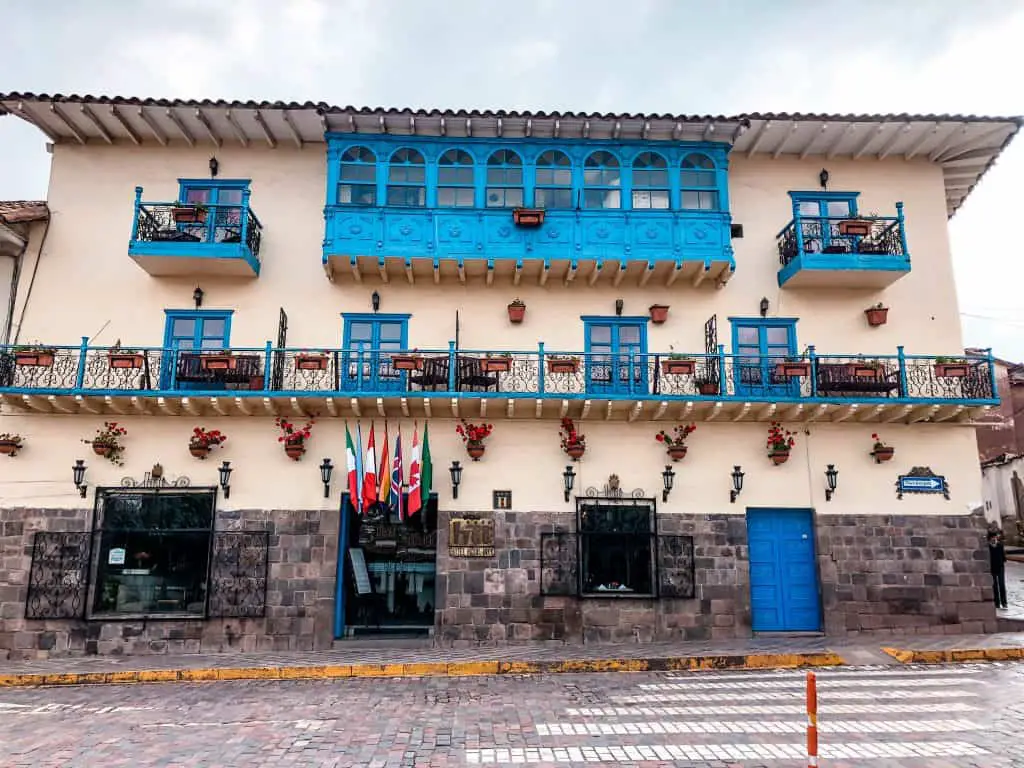
Solo Female Travel Safety Tips for Cusco
Generally speaking, Cusco is a very safe place for solo female travelers. Compared to other cities I visited, I didn’t experience any street harassment from men while there. I also felt safe when I walked back to my hostel alone at night after dinner, although I stayed on well-traveled and well-lit streets. That being said, there are a few solo travel safety tips to consider when visiting Cusco.
Stay Alert in Crowded Areas: Cusco’s bustling markets, plazas, and tourist spots can be hotspots for pickpockets. Keep your belongings secure, avoid displaying valuable items, and stay vigilant, especially in crowded places like the San Pedro Market and the Plaza de Armas.
Know Your Limits with Alcohol: While Cusco has a vibrant nightlife, be mindful of your alcohol consumption. Drink responsibly, never leave your drink unattended, and avoid accepting drinks from strangers.
Beware of Altitude Sickness: Cusco is situated at 3,400 meters (11,150 feet) above sea level, which can cause altitude sickness. Take it easy on your first couple of days, stay hydrated, avoid alcohol, and consider acclimatization aids like coca tea or soroche pills.
Drink Bottled Water: Tap water in Cusco isn’t safe to drink, so stick to bottled water or refill your reusable water bottle using the filtered water provided by most accommodations.
Use Trusted Tour Operators: When booking tours, especially for activities like trekking or visiting Machu Picchu, use reputable tour operators. Look for reviews and ensure they follow safety protocols and have proper licensing. In this post, I’ll recommend some great tour companies.
Stay in Safe Neighborhoods: The historic center (Centro Histórico) and neighborhoods like San Blas are popular and safe for tourists. Avoid poorly lit or deserted areas at night, and always check for recent safety reviews of your chosen area.
Respect Local Customs: Peruvians are generally warm and welcoming, but it’s important to respect local customs and traditions. Also, please know that the women and children dressed traditionally with alpacas typically don’t mind if you take their photo as long as you compensate them for it. This is their job; please respect that.
Know Local Emergency Numbers: In Cusco, the emergency number for police is 105, and for medical emergencies, it’s 106. Keep these numbers handy, along with contact details for your country’s embassy or consulate.
Trust Your Instincts: Trust your gut if something doesn’t feel right. It’s better to err on the side of caution and remove yourself from uncomfortable or potentially dangerous situations.
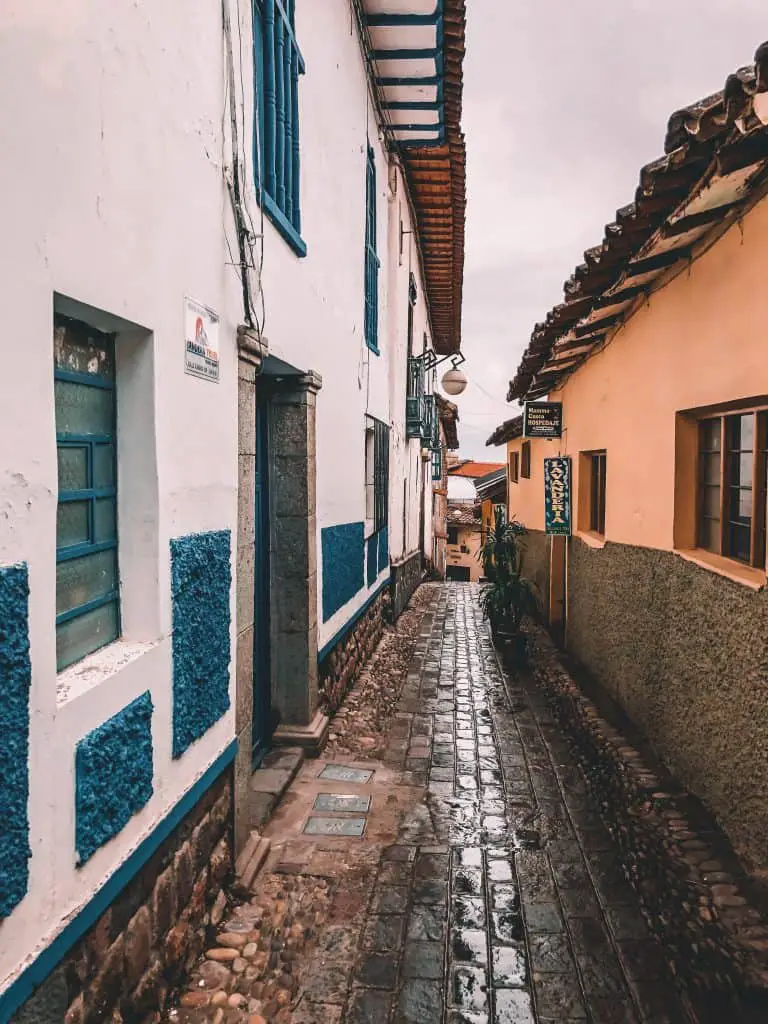
The Best Time of Year to Visit Cusco
Cusco is a beautiful place to visit any time of year, but there are some weather considerations, especially if you have lots of outdoor adventures on your itinerary. I visited in March, during the rainy season, and it certainly rained quite a bit, which made the trek to Machu Picchu interesting, to say the least. As long as you pack appropriately for the season, you can enjoy all that Cusco has to offer.
Dry Season: April to October
The dry season is generally considered the best time to visit Cusco, especially for outdoor activities. During this time of year you can expect plenty of sunshine with day time temperatures ranging from 15°C to 20°C (59°F to 68°F), making it perfect for outdoor activities and sightseeing.
As the weather is perfect for the outdoors, this is the peak season for tourists wanting to hike the Inca Trail, the Salkantay Trek, or other mountains in the area. This means that these popular sites will be crowded, and prices for accommodation will be higher. Book accommodation and tours well in advance!
Rainy Season: November to March
If you visit during the rainy season and are well prepared by following this Cusco packing list and managing expectations, you can have a great time in Cusco.
You’ll experience frequent rain showers in the afternoons and daytime temperatures ranging from 17°C to 19°C (63°F to 66°F). This rain turns the Sacred Valley into a lush paradise with gorgeous waterfalls!
Since the weather isn’t ideal, there are fewer tourists, which means you can enjoy a more tranquil experience in the ancient ruins (it is amazing to see Machu Picchu without the crowds).
The weather also makes trekking a bit more challenging, as the trails are muddy and slippery. You may even encounter landslides (I did!). So be sure to book with reputable tour guides!
The Inca Trail hike does close during the month of February for maintenance.
Another bonus for traveling to Cusco during the rainy season, besides fewer tourists is lower prices for accommodation.
Shoulder Seasons: April-May and September-October
The shoulder seasons balance the dry and wet seasons, so if you want decent weather with fewer crowds, this is the perfect time of year to visit.
In April and May, the rains taper off, and the landscape is still lush from the wet season. September and October are similarly pleasant, with milder weather and clear skies.
Easter and Semana Santa (Holy Week) in April are significant cultural events with vibrant processions and celebrations. Crowds and prices may increase during this time, but it’s a great way to experience local culture and traditions.

The Cusco Tourist Ticket (Boleto Turistico)
The Cusco tourist ticket is an excellent way to explore many of the city’s attractions. There are different ticket options, with the most comprehensive one providing access to over 16 sites throughout Cusco and the Sacred Valley.
The tickets can be purchased at any of the archeological sites included in the ticket or at ticket offices in Cusco. You will need your passport to make your purchase. Students can get these at a discounted rate.
The Full Tourist Ticket
This option allows you to visit 16 sites within the city of Cusco and the Sacred Valley. It is the most expensive option, and you have ten days to use it from the first day of use.
The Partial Tourist Ticket
This ticket has three different options depending on the sites you want to see, each with a different length of use.
I purchased the full tourist ticket at Saqsayhuaman and also used it for entry into Pisaq and Ollantaytambo. I even visited a few museums in Cusco because I had it that I likely would’ve skipped without it.
The Best Things to Do in Cusco, Peru
Explore the Plazas
Cusco has a number of plazas, each with its own vibe that are worth checking out.
Plaza de Armas
Cusco’s Plaza de Armas is the city’s vibrant and busy main square. Here, you will find two important buildings: the Cathedral of Cusco and the Church La Compañia de Jesus. The Spanish built these two churches on top of Incan palaces. You can actually still see the Incan stones that formed the foundations for the churches.
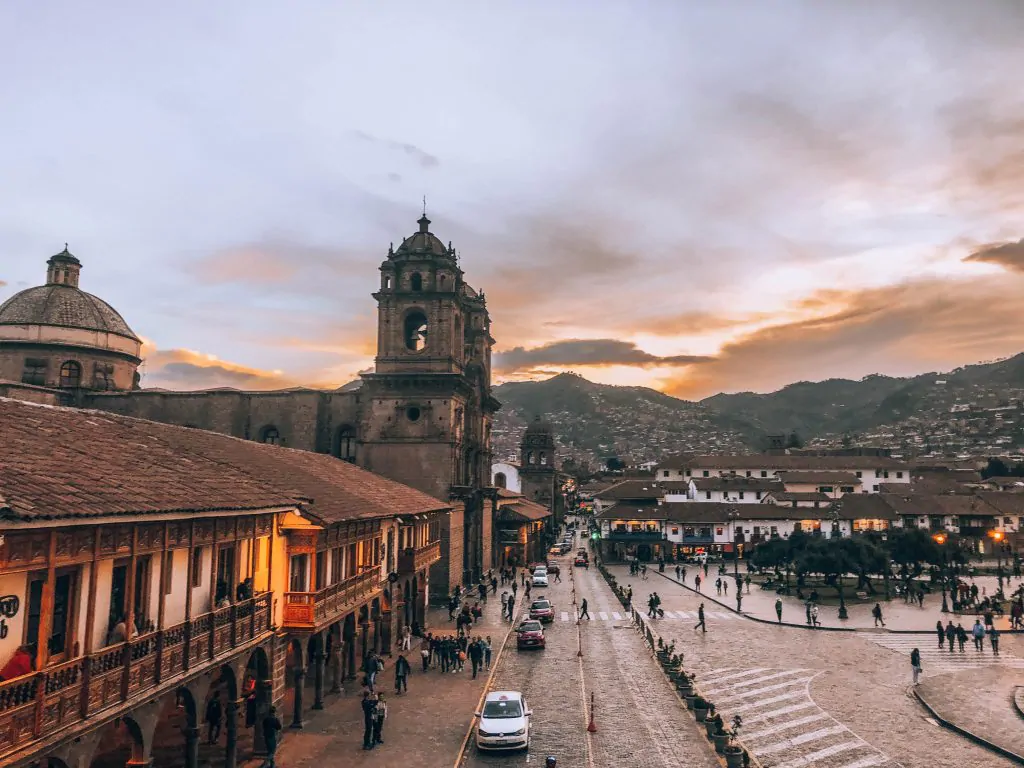
The center of Plaza de Armas has a beautiful garden, fountain, and benches that are perfect for people-watching in this busy square. Large pedestrian-only cobblestone streets surround it. Lining the streets are hiking stores, tour companies, McDonald’s, Starbucks, jewelry stores, and other various amenities.
While I don’t normally recommend going to Starbucks, especially when there are much better coffee shops in Cusco, it actually makes an excellent place to watch the sunset over the plaza.
The Plaza de Armas is where you’ll find a variety of street vendors, young children and women mostly. A simple no thank you or no gracias will suffice if you’re not interested in what they’re selling.
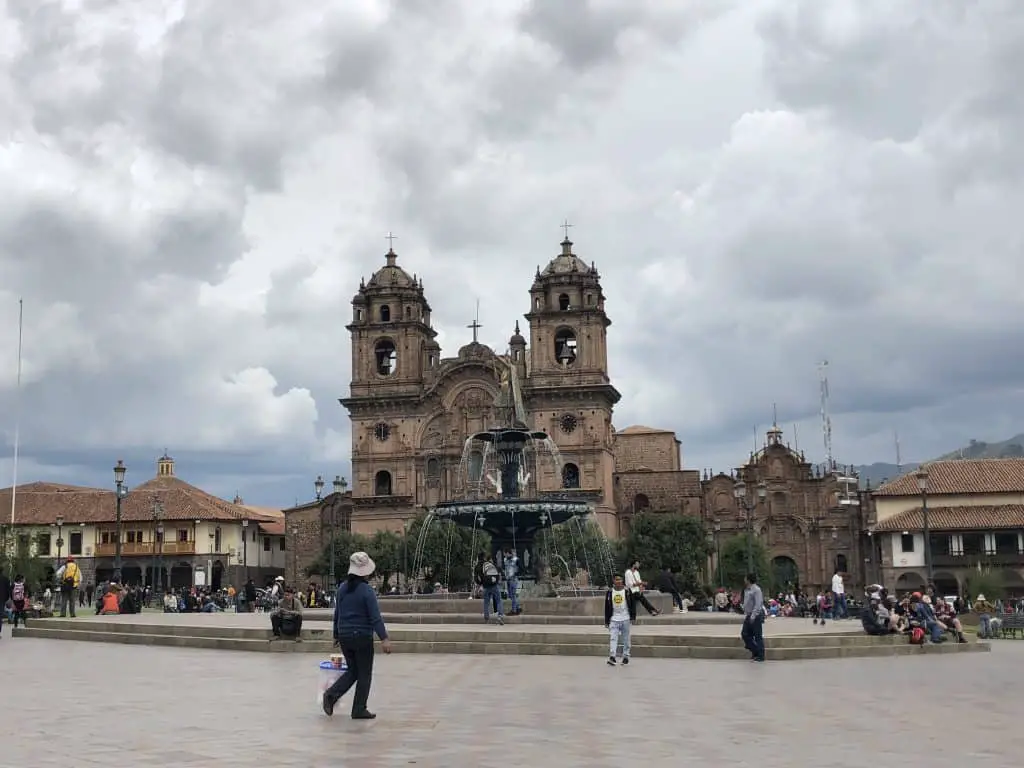
Plaza San Blas
Plaza San Blas is sort of the bohemian area of Cusco. It is a short walk from Plaza de Armas.
Follow Calle Hatunrumiyoc, you will see those large Incan stones underneath Spanish-style buildings. You’ll pass by the popular Jack’s Cafe, where you’ll likely notice a line, and then you’ll see an uphill path. Walk uphill to Plaza San Blas.
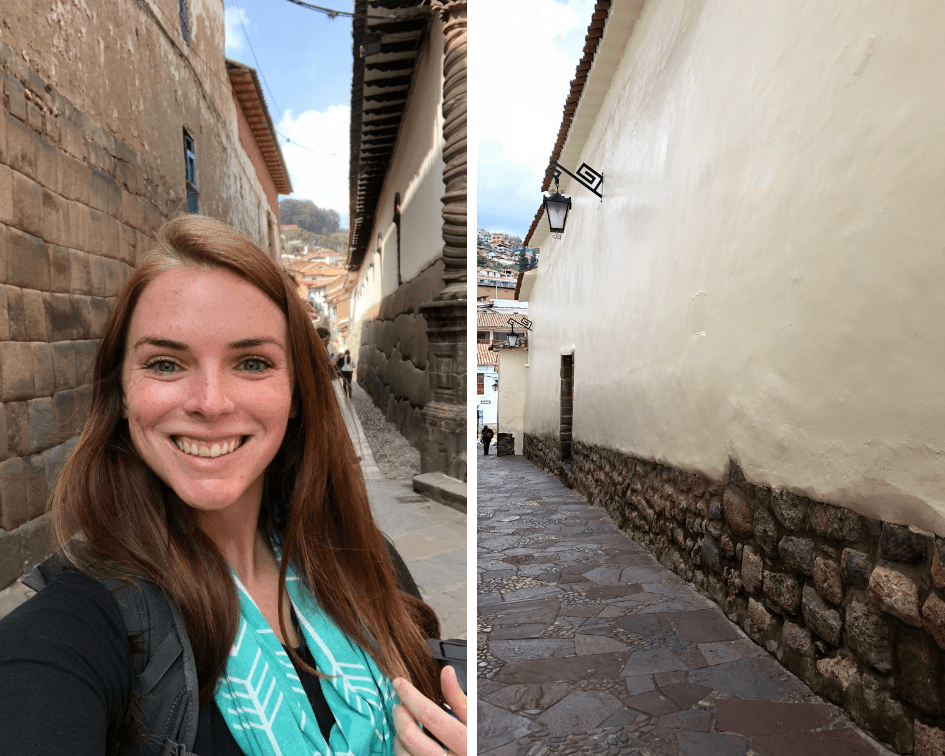
The Plaza offers a number of great restaurants and two of my favorite Cusco cafes, The Meeting Place and Cafe Loco. There is also an artist’s market in the Plaza on Saturdays.
Beyond the plaza is the bohemian district of San Blas, which I found to be a bit quieter than the rest of Cusco. This area is quite hilly, so be prepared to walk uphill at altitude. But the effort is well worth it, as the winding streets offer unique shops, art galleries, and yoga studios.
If you’d like to stay in this neighborhood, there are a number of hostels and hotels.
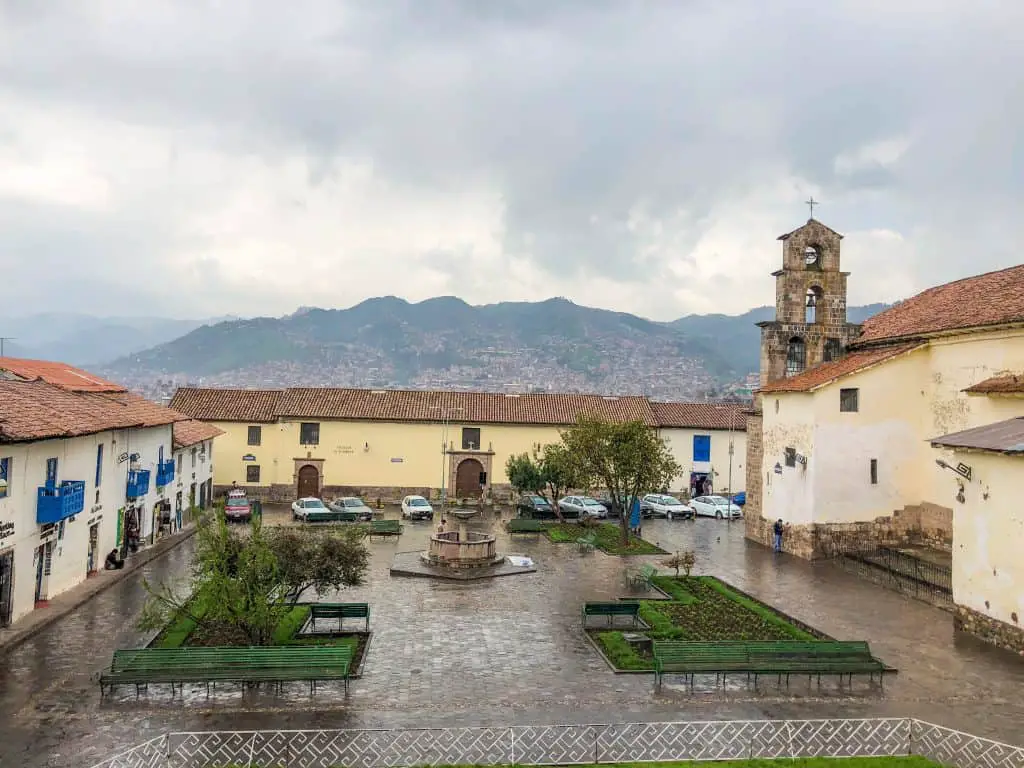
Plaza San Cristobal
Just below Saqsayhuaman is Plaza San Cristobal, located next to the San Cristobal Church. Locals and tourists alike gather here in the afternoon to relax and take in the views of the Incan capital city. In the church, you can climb the bell tower for more views of the city. I did not make the climb as I quite enjoyed the view from the Plaza.
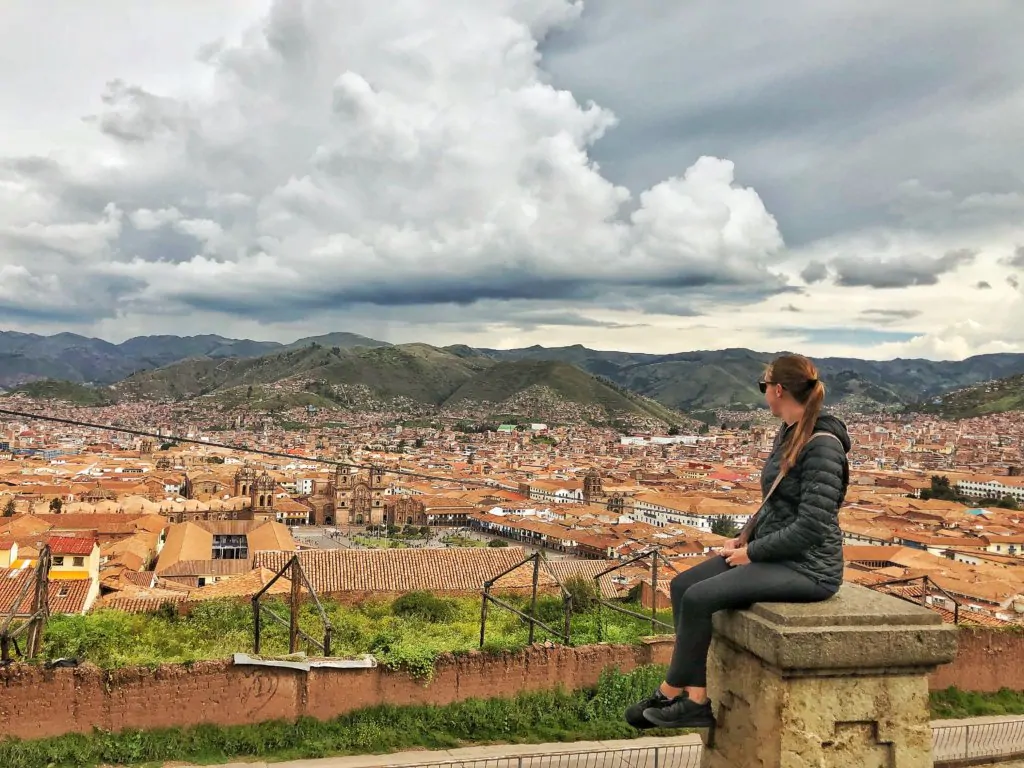
Plaza El Regocijo
Just on the other side of Plaza de Armas, the opposite direction of Plaza San Blas is Plaza el Regocijo. Here you will find the Museum of Chocolate, Peru Rail’s office, and one of the best restaurants in Cusco that I highly recommend – Chicha por Gaston Acurio.
The Modern Art Museum is here as well, which has a beautiful courtyard and is included on your full tourist ticket.
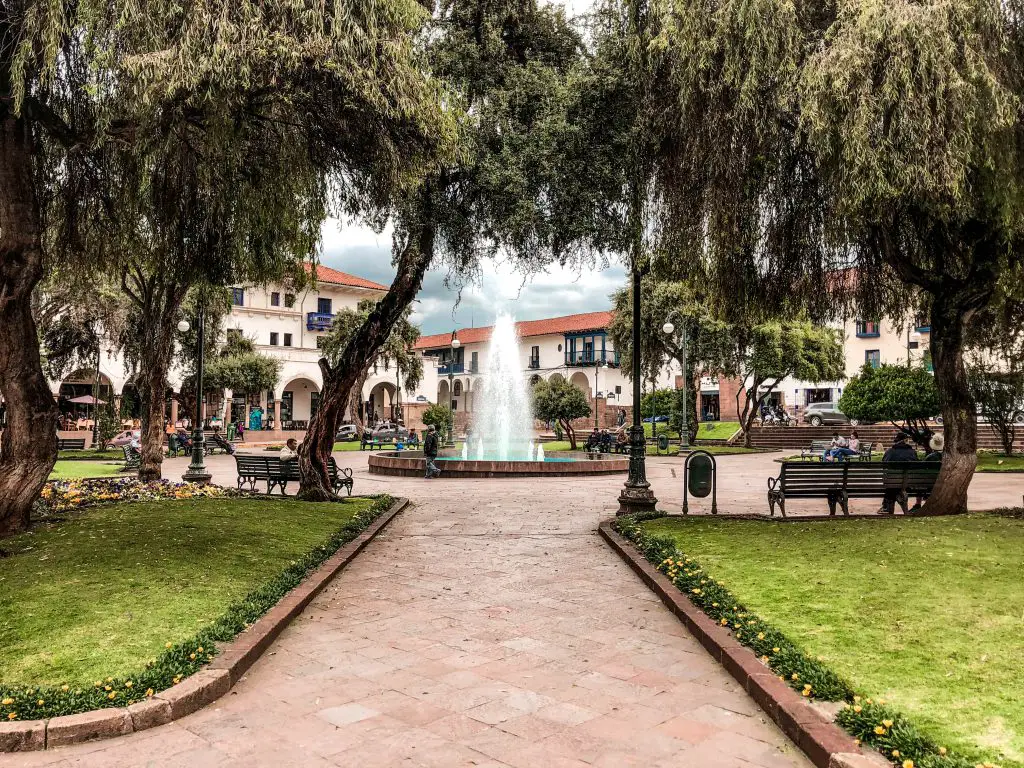
Eat & Shop at San Pedro Market
The Mercado Central de San Pedro is an amazing market where you will find fresh produce, delicious juices, and various Peruvian goods. You can get sweaters made from Alpaca wool while sipping fresh juice with the smell of Lomo Saltado in the air.
Visiting the San Pedro market is a great way to spend a morning, but get ready to haggle if you want to get a good price on something!
Visit Saqsaywaman and Cristo Blanco
Saqsayhuaman (pronounced like sexy woman) is on the outskirts of Cusco but it is walkable from Plaza de Armas. However, the altitude makes the uphill climb even more challenging so it’s best not to do this on your first day. Once you’ve learned you’re ok with the altitude, the walk will help you acclimatize for the trek to Machu Picchu.
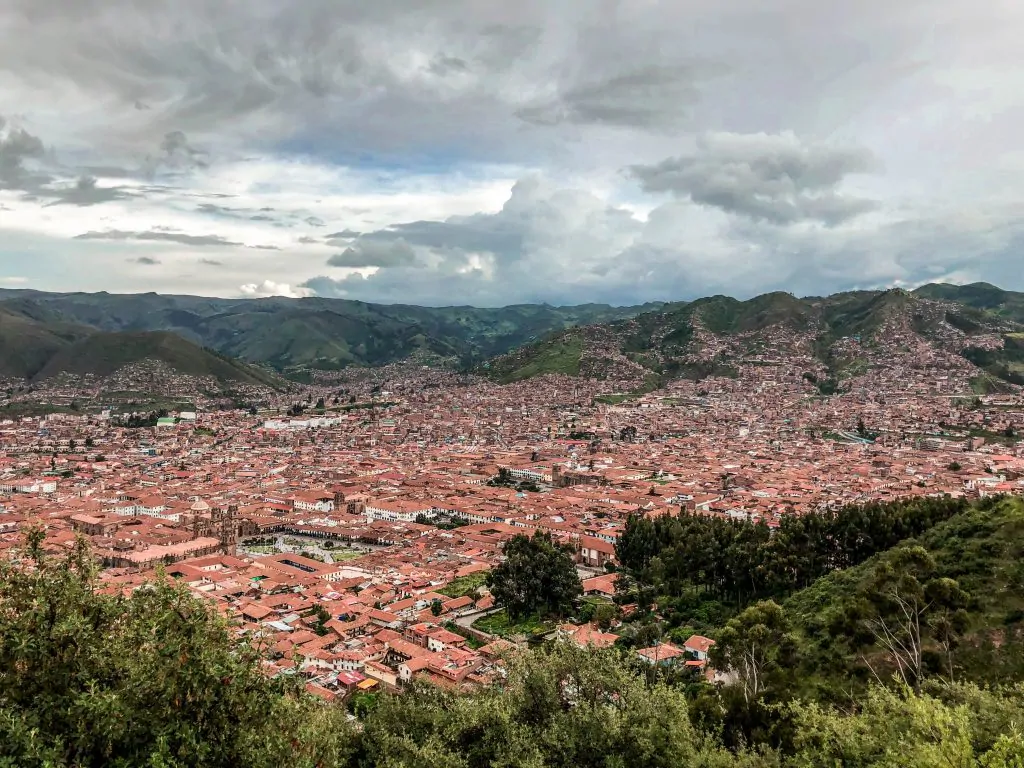
Visiting Saqsaywaman requires the Cusco tourist ticket, which you can purchase upon entry.
Saqsaywaman was a military fortress that protected Cusco. It was also a place for Incan rituals and ceremonies. The stones here survived many earthquakes that have hit Cusco over the centuries. However, once conquered, the Spaniards took the stones to build a new Cusco.
As you enter Saqsaywaman, go towards the left for awesome views of Cusco. It would be a great place to watch the sunset, but it’s only possible to see the start of it as the site closes around 6:00 pm.
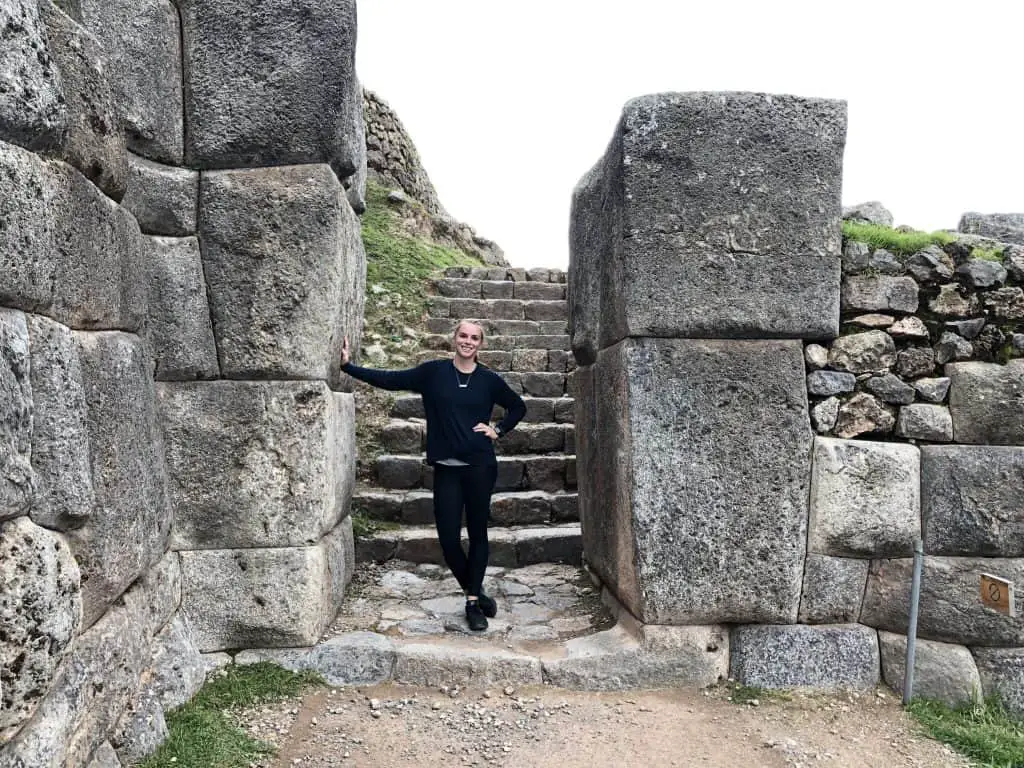
Please be respectful of this site and do not stand on the stones.
Across the way is Cristo Blanco, which is free to enter! From this 8m high statue of Jesus Christ embracing the people of Cusco, you can catch the remainder of the sunset!
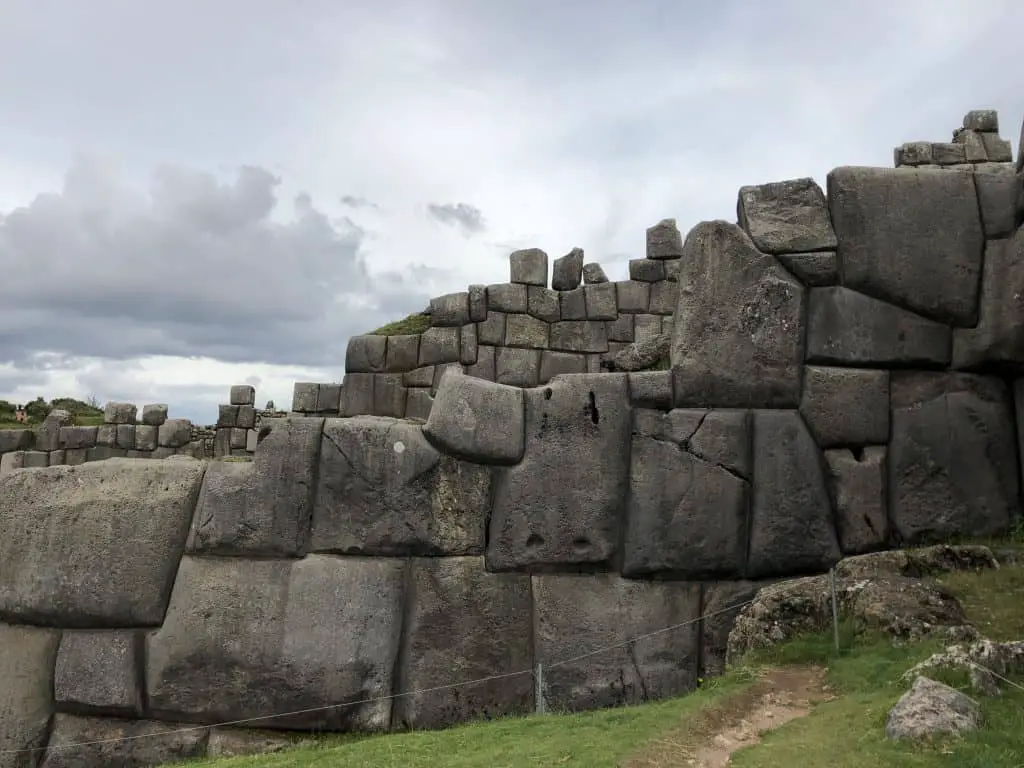
Take a Yoga Class
When I was in Cusco, I took an amazing yoga class at The Healing House, which is now called Pachanda Retreat Center. At the time, they allowed for drop-in yoga classes, but now it’s geared more toward retreats, yoga teacher training, and other healing events. If that sounds like something you’d be into, check them out here.
Studios like Exhala Yoga offer more yoga options. Exhala offers daily yoga classes, but you can also combine your class with a wellness package, which includes a steam room, jacuzzi, and massage. Exhala Yoga is located in the Antigua Casona de San Blas Hotel.
Get a Massage
There are a number of women in Plaza de Armas offering massages for incredibly cheap prices. I didn’t quite trust the safety of these services and sought out the recommendation of a masseuse while I was booking my ticket at the Peru Hop office.
It cost considerably more than what the ladies offer in the streets, more on par with US prices, but I felt more comfortable.
The place is called Ajna Holistic and is on the second floor of the building, on the same street as Peru Hop.
Believe me, you’ll be desperate for a massage after your trek to Machu Picchu.
Enjoy the Cusco Nightlife
I didn’t party in Cusco at all as I had issues with the altitude and wanted to be in the best shape for the Salkantay Trek to Machu Picchu I’d booked.
However, Cusco is famous for its nightlife! You could keep it simple with a beer at the highest Irish pub in the world (Paddy’s Irish Pub) or dance the night away (Mama Africa), there is something for you to enjoy a fun night out.
Just make sure you’re acclimated to the altitude first because a hangover at altitude is a different kind of beast (something I learned living in Quito)!
The Best Day Trips from Cusco
With your tourist ticket, you will have access to a number of sites in the Sacred Valley. Book a guided tour to some of these ancient sites, like Pisaq and Ollantaytambo. The tour should include lunch and transportation.
Pisaq
Pisaq (also spelled Pisac) is a small town in the Sacred Valley about 20 miles northeast of Cusco. It’s known for its Incan ruins and vibrant market.
Pisaq was once a ceremonial and agricultural center that guarded the southern entrance of the Sacred Valley, controlling access to the jungle.
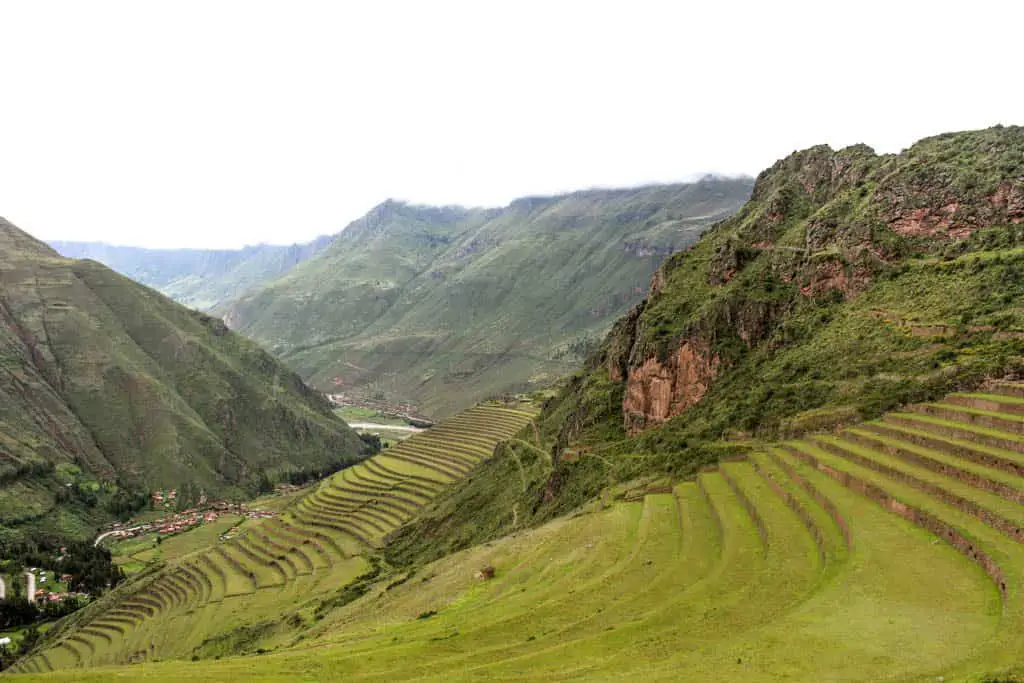
The archeological site was built on a hill overlooking the Vilcanota River. The site is divided into sections, including religious temples, like the Sun Temple, where Incans performed rituals. There was also a residential area. Perhaps most notable are the intricate architectural terraces that the area still uses today.
Pisaq is also well known for its market, which will be a stop on your tour. Here, you can buy jewelry and other Peruvian textiles which make for great souvenirs.
Book your Pisaq day trip here.
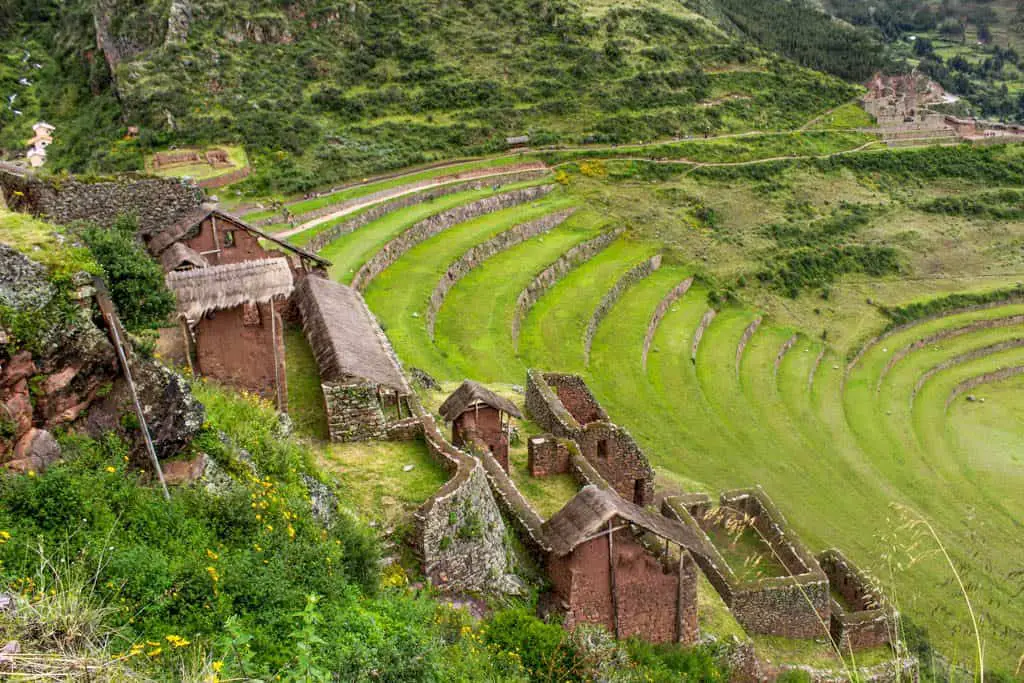
Ollantaytambo
Ollantaytambo is a bustling Incan town that still has the original street grid with irrigation channels and cobblestone paths. The town showcases the advanced urban planning of the Incas, and walking through the streets is like stepping back in time.
Perched on a hillside near the town are the Pinkulluna Ruins, which were storehouses for agricultural products. You can climb up the agricultural terraces, exploring the buildings and temples of the complex.
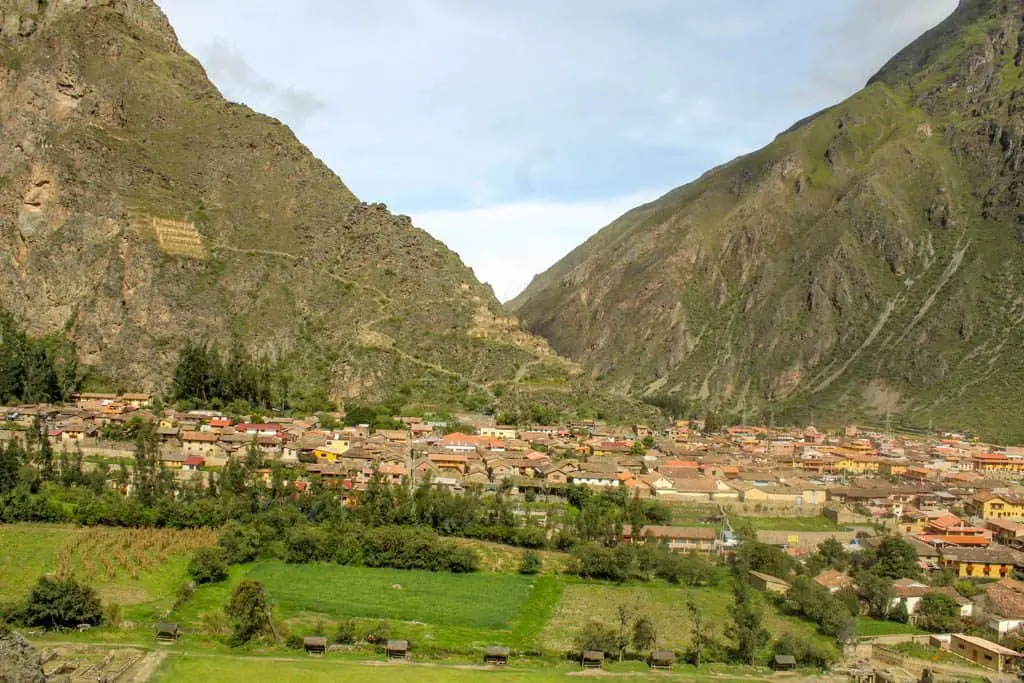
From the top of the complex, you can see storehouses built into the side of the mountains where Incans would store their harvest. Ingenious!
The Inca trail also starts in Ollantaytambo, so if that’s the trek you’ve chosen for Machu Picchu, then I highly recommend staying the night here to enjoy the unique experience of staying in an Incan village.
Book your Ollantaytambo day trip here.
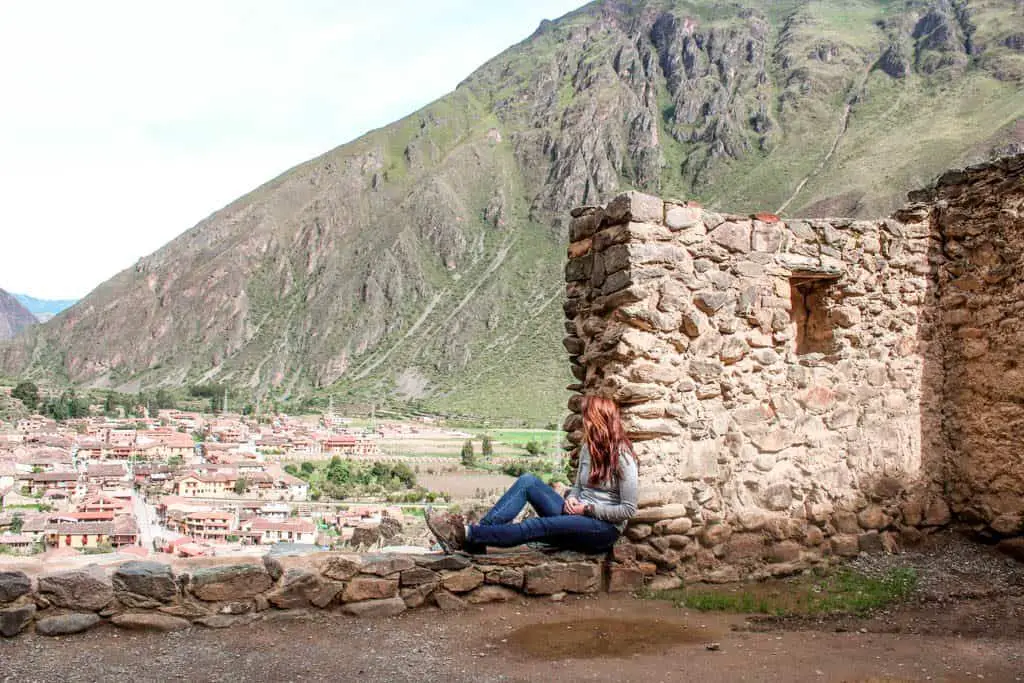
Hike Rainbow Mountain
This was high on my Cusco bucket list.
I really wanted to do this hike. However, as I visited during rainy season my hostel informed me that the weather was incredibly unpredictable and it could snow, which meant no hike.
I actually talked to someone on Instagram who had her trek canceled due to snow just a week prior. I also learned that the day tour started at 3:00 am, with a few hours on a bus before the hike even started. Which, quite honestly, sounded miserable.
I opted to skip it and save my money and energy. For more information about this hike and other awesome hikes in Peru, check out this Peru hiking guide.
If the weather is better during your trip, book your day Rainbow Mountain Hike here!
Maras Salt Mines
Honestly, I didn’t even know this existed while I was in Cusco. I learned about it from Instagram photos long after I returned home. I wish I knew about it because it looks quite interesting.
The Maras Salt Mines are ousands of pools that are fed by a natural underground saline spring. The Incans learned how to diver the saline water into terraced pans. The water evaporated in the sun, leaving behind crystallized salt.
Today, each pan is managed by a local family who harvests salt using traditional methods.
If I’m ever in Cusco again, which I hope to be, it’ll be on my list!
Book your day trip to the Maras Salt Mines here.
The Best Restaurants in Cusco
Some of the best meals I’ve had in my life were in Cusco. Everything from the street food to the cafes to the fine dining is delicious. Even non-Peruvian cuisine is great here!
A few spots I highly recommend checking out are:
Cicciolina
Cicciolina is a popular tapas bar with great cocktails located just a block away from Plaza de Armas. I sat at the bar, which is one of my top tips for being comfortable eating alone, and ordered a wide variety of tapas with a pisco sour to drink. The service was excellent, the food mouthwatering, and the pisco was perfect. It felt like such an indulgence because I ate quite a bit, but the price was reasonable!
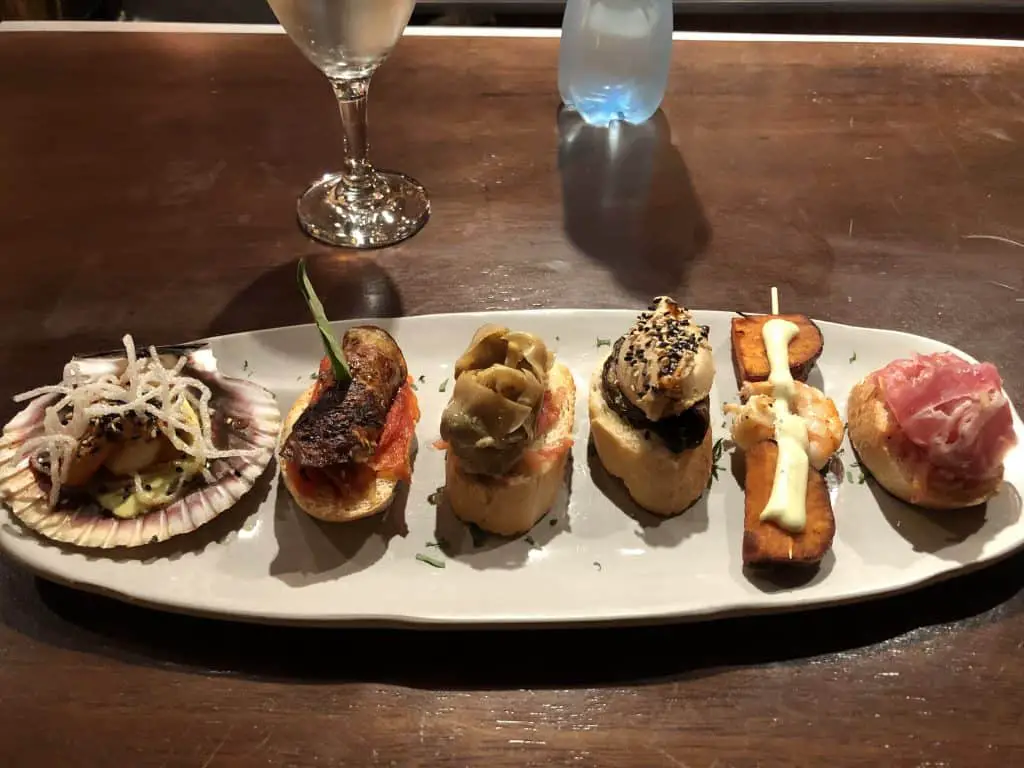
Chicha por Gaston Acurio
Gaston Acurio is a Peruvian chef who helped make Peruvian cuisine world-renowned. So, I jumped at the chance to eat at one of his restaurants, Chicha. Reviews stated there was usually a wait and reservations were required. However, I wandered in mid-afternoon, somewhere between lunch and dinner, and was seated immediately. Other diners were there, too. I’m sure going right at dinner or lunch increases your wait time.
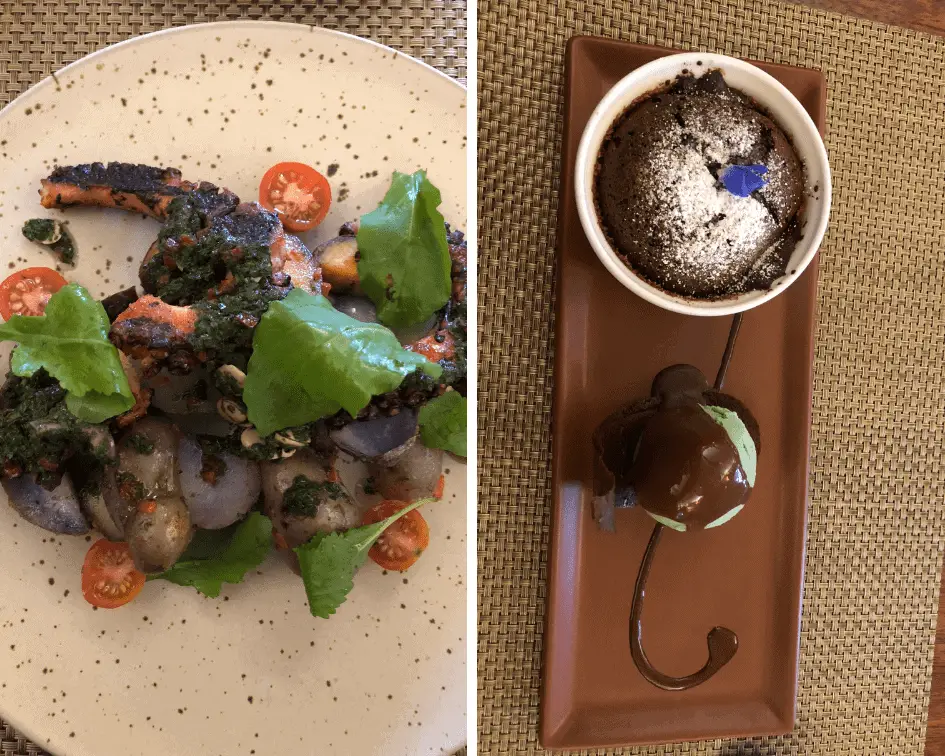
Following the advice of a friend, I ordered the pulpo salad and freshly squeezed juice. Although the cocktail list was enticing, I went before I hiked to Machu Picchu and was abstaining from alcohol. The pulpo salad was so freaking good, and I also had some space left for dessert so I ordered the chocolate souffle. The service was excellent and the price was very reasonable for a fine dining type restaurant.
Limbus Restobar
Located in trendy San Blas, Limbus Restobar has the best view of Cusco City. Get there early to grab a spot on their balcony to watch the sunset and lights turn on over the city. On chilly nights, they provide blankets to make sure you’re comfortable. If the balcony is full, rest assured that the huge windows will still provide excellent views.
The food and drink at Limbus are equally worthy of the climb up the hill. I ordered anticuchos and ceviche while enjoying the view of Cusco below.
Papachos
Sometimes, when I’m traveling, I just want a good burger. So I went to Papachos, which overlooks the Plaza de Armas, and I actually scored a balcony seat at sunset! Papachos is another of Gaston Acurio’s restaurants and the burger was really good. They also brought me a blanket once the sun was gone!
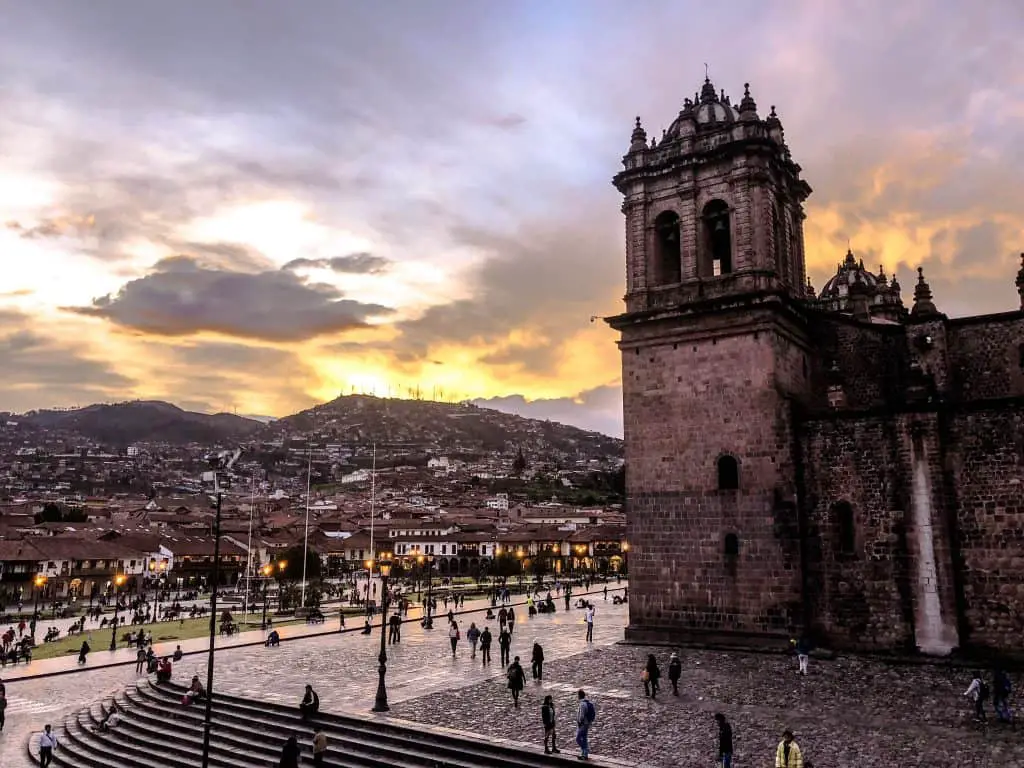
Where to Stay in Cusco, Peru
There are several accommodation options in Cusco. Depending on your budget and travel style, you can stay in a backpacker hostel or a 5-star hotel. I am a budget traveler, so I stayed at Millhouse Hostel, which is now called the Pariwana Hostel. It was a great spot to stay!
If you don’t like hostels, don’t worry. I have solid recommendations besides hostels below to help you decide where to stay in Cusco.
Hostels in Cusco
Since Cusco sees a large number of backpackers, there are a number of amazing hostels to choose from that are great for meeting people when you’re traveling solo.
Selina Plaza de Armas
I would call Selina Plaza de Armas a boutique hostel. It is set in a Colonial-style building just steps from Plaza de Armas. It’s actually near Plaza Regocijo which I mentioned above. They offer traditional hostel dorm rooms, private rooms, and cozy teepees! There is also an on-site restaurant called Howm and coworking spaces if you need it.
Check rates and availability here.
Kokopelli Hostel
Kokopelli Hostel was recommended to me by people in my Salkantay Trek group. They’d stayed there before the trek and said it was great! It offers free walking tours of the city, an onsite bar, and daily activities to get to know people and Cusco. They have shared dorms (including female only) that have wooden pods with their own light and curtains for privacy. They also offer private rooms with a private restroom.
Check rates and availability here.
Pariwana Hostel
Pariwana Hostel, formerly known as Millhouse Hostel, is in a gorgeous Colonial building with a center courtyard and a variety of room types available. It did have a bit of a party hostel vibe when I stayed there, so if that’s not your vibe, I’d recommend staying elsewhere. But it does make for a great way to meet fellow travelers!
Check rates and availability here.
Mid-Range Accommodations in Cusco
If hostels aren’t your thing but you also don’t want to spend too much money on your accommodation, consider one of these awesome hotels in Cusco that are budget-friendly but not a hostel.
Antigua Casona San Blas
Antigua Casona provides a warm and inviting atmosphere for its guests. It’s in a historical colonial mansion, and they kept the stone archways and used traditional Andean decor. There are 16 rooms, some of which have balconies overlooking the courtyard. There is a cozy bar and complimentary breakfast. Plus, there are daily yoga sessions and cooking classes if you want to learn how to cook some delicious Peruvian food. I would 100% stay here.
Check rates and availability here.
Quinta San Blas
Quinta San Blas is a charming boutique hotel in the San Blas neighborhood. It’s set in a colonial-ear building with a lovely courtyard. The rooms are well decorated, there is daily breakfast, and friendly reception staff. This is a great place to stay where you get a ton of value and service and a great price.
Check rates and availability here.
Casa Andina Premium Cusco
Casa Andina is a somewhat larger hotel with 93 modern rooms. It is located just steps from all of the fun things to do in Cusco. The reviews state the staff provides excellent service and the onsite restaurant, which has great reviews, provides an included breakfast! There is also an onsite spa! This is a great place to stay if you want the vibes of a luxury hotel without the price tag.
Check rates and availability here.
Luxury Accommodation in Cusco
The luxury hotels I mention here are perfect for a dreamy getaway while also immersing yourself in the culture. The hotels I mention here are steeped in history and you’ll see that in how they used the Incan stone walls and traditional decorations.
Inkaterra La Casona
Inkaterra La Casona is a luxury boutique hotel in a 16th-century mansion. The luxurious rooms are updated while still feeling like you’re stepping back in time. There are 11 suites with fireplaces, heated floors, and extra-large bathtubs! There is a spa and restaurant on site. Sleeping here would be like stepping into Incan culture. This is a bucket list place for me to stay one day.
Check rates and availability here.
Palacio Nazarenas
Palacio Nazarenas is a five-star hotel managed by Belmond. It’s set in a former 16th-century convent. The hotel has been beautifully restored, keeping many original features while adding in modern luxuries. There are 55 suites with oxygen-enriched air (amazing for helping with altitude issues), an outdoor pool, an onsite spa, and a restaurant.
Check rates and availability here.
Palacio del Inka
Palacio de Inka is a five-star hotel in a 500-year-old mansion! A gorgeous spa on site, two restaurants, and luxurious rooms are a great retreat after a day of exploring. It’s in a great location near the Plaza de Armas. It’s also a Marriot Property, so if you have points, use them!
Check rates and availability here.
Do you feel ready for your trip to Cusco, Peru? I hope that this Cusco travel guide has given you some great ideas to build your own bucket list Cusco itinerary. It’s a truly special place filled with rich history and natural beauty. Have fun exploring!
Like this post? Pin it for later!


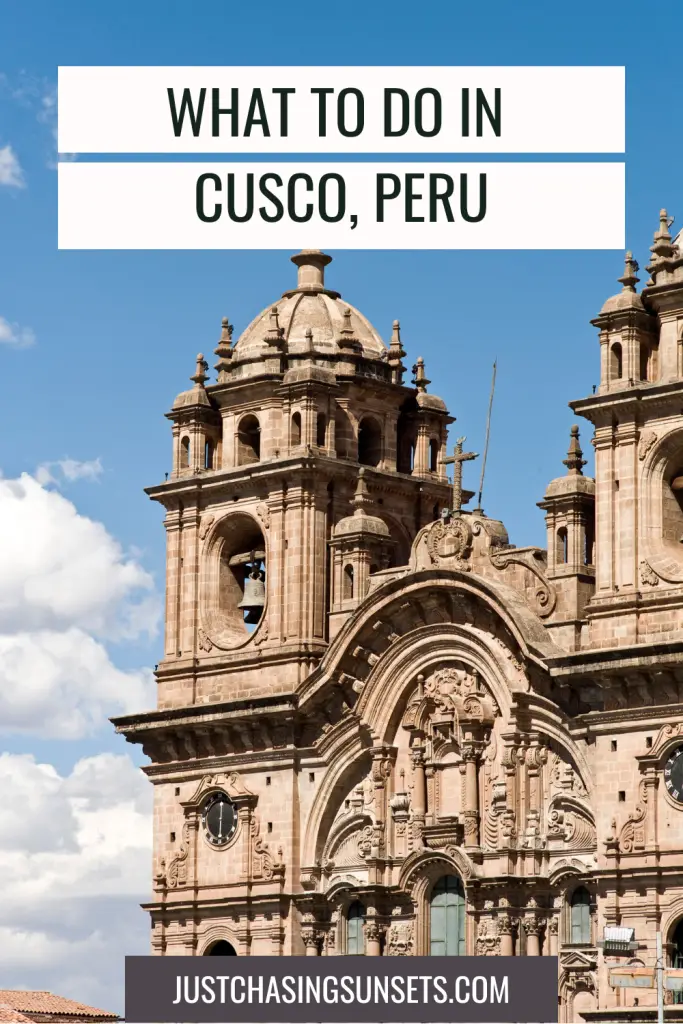
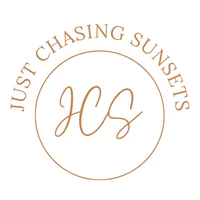
I love how easy it is to customize this guide!
Yes! So important to make a trip your own!
I loved Cuzco and your Itinerary is completely awesome! I also like the part about taking care of yourself, which is actually really good to think about considering the high altitude in Cuzco!
Yea – that altitude is no joke! So glad you enjoyed the post!
Wow this is such a well thought out guide! You covered everything, this post is so helpful.
I would love to go to Sacred Valley.
I definitely want to go back and see more of it…perhaps even staying there instead of Cusco!